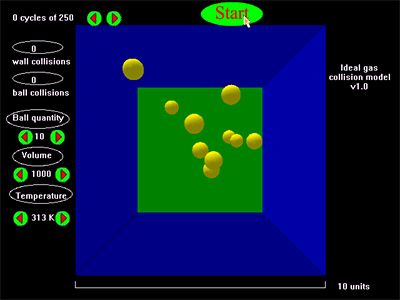The ideal gas collision model.
Description
This model simulates the collisions of molecules in ideal gas at varying conditions. According to the experience of Ph.D. V.V.Zagorski, it is usually difficult for students to explain precisely how do the various factors influence the rate of chemical reaction, which leads to misunderstanding on the part of their pupils (for example, pupils usually confuse the concentration and quantity).
The purpose of this model is to demonstrate how temperature, concentration and time influence the number of collisions between molecules in ideal gas. The number of collisions between molecules is counted, alongside with the number of collisions between walls and molecules, as these microparameters influence the rate of the reaction.
To simplify the model, it was stated that all the molecules have the same kinetic energy (E=3kT/2), only one type of them is taken and the gas used is considered ideal (molecules only interact by colliding with each other and the walls).
Working with the model
The main screen of the program contains the simulation part (a blue/green cube with yellow molecules inside), the conditions/results part on the left, and the "Start simulation" button.
The simulation part can't be interacted with; its purpose is to show the behavior of molecules in given conditions.
In the conditions/results part temperature, duration, volume and quantity can be adjusted
by clicking on corresponding arrows. The temperature can be adjusted from 313 to 353 K
(40 to 80 degrees Centigrade); the number of molecules can be varied from 10 to 80, and the
volume can be varied from 1000 to approximately 37000 cubic units (the volume of one molecule is
4p/3 cubic units). The scale under the simulation part shows the linear dimensions of the cube.
The duration of the simulation can be adjusted by clicking the arrows near the cycles counter.
The duration of each cycle depends on computer's CPU and memory available.
The simulation is started by clicking on the "Start" button, and it shows real-time molecular movement simulation, while producing real-time results in "Ball collisions" and "Wall collisions" counters. During the simulation, the parameters are unchangeable and the number of cycles elapsed is displayed in top left corner of the screen. Each collision is accompanied by a distinct sound, different for wall and molecule collisions. Spacebar instantly stops the simulation and resets the counters.
To exit the program, press Esc.
System requirements
DirectX 7.0 or higher is needed to run the program. (included on the disk; freely downloadable in the Internet version), sound card with sound output device is needed to hear the sounds.
Monitor must support 640x480x16 mode.
Credits:
Model done with Dark Basic 1.09C by Dmitry Mendeleev for the Russian-Dutch educational project.
All rights reserved.
| 



